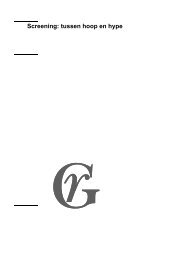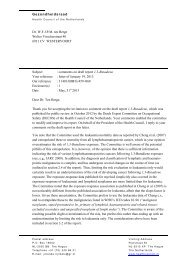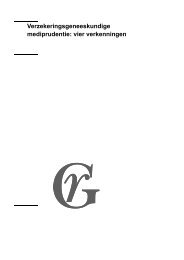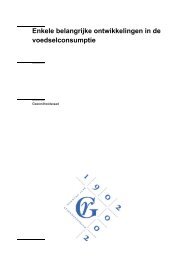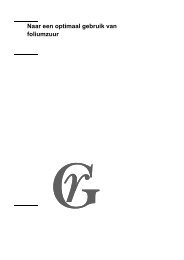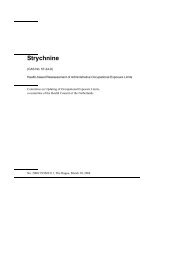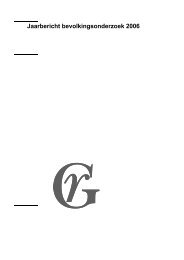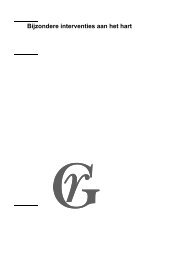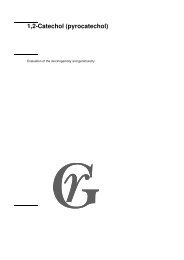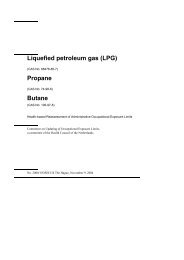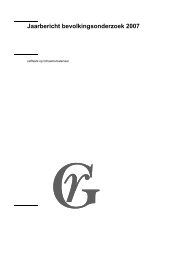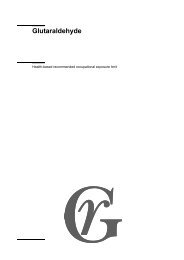Health Council of the Netherlands Reports 2003 - Gezondheidsraad
Health Council of the Netherlands Reports 2003 - Gezondheidsraad
Health Council of the Netherlands Reports 2003 - Gezondheidsraad
Create successful ePaper yourself
Turn your PDF publications into a flip-book with our unique Google optimized e-Paper software.
Research results<br />
The techniques developed have undergone various forms <strong>of</strong> testing in <strong>the</strong><br />
laboratory. Inactivation experiments have been performed with viruses and, to a<br />
lesser extent, with bacteria and parasites. Inactivation <strong>of</strong> viruses usually results in<br />
a reduction <strong>of</strong> at least ten thousand-fold. In <strong>the</strong> case <strong>of</strong> extremely large quantities<br />
<strong>of</strong> micro-organisms, however, <strong>the</strong> inactivation techniques appear to result not in<br />
total inactivation but merely a numerical reduction. This limitation <strong>of</strong> <strong>the</strong><br />
technique places question marks over <strong>the</strong> possibility <strong>of</strong> dispensing with o<strong>the</strong>r<br />
safety measures when introducing inactivation techniques.<br />
Experiments with blood products such as platelets, plasma and red blood<br />
cells demonstrate that, although <strong>the</strong> products may well still conform to <strong>the</strong><br />
relevant quality requirements, <strong>the</strong> treatment usually has a negative impact on<br />
quality.<br />
The toxicological research conducted to date has largely focused on <strong>the</strong><br />
question <strong>of</strong> whe<strong>the</strong>r <strong>the</strong> substances used to treat <strong>the</strong> blood products, which bind<br />
to DNA or RNA, still elicit harmful effects following completion <strong>of</strong> <strong>the</strong><br />
procedure. The results <strong>of</strong> <strong>the</strong> research indicate that this is not <strong>the</strong> case. However,<br />
it is not clear what consequences exposure in <strong>the</strong> long term, or – in <strong>the</strong> case <strong>of</strong><br />
patients receiving blood products on a regular basis – repeated exposure to small<br />
quantities, might have. Owing to <strong>the</strong> limitations <strong>of</strong> <strong>the</strong> research conducted to<br />
date, a definitive verdict on <strong>the</strong> safety <strong>of</strong> <strong>the</strong> techniques will probably only be<br />
possible following large-scale administration, as in <strong>the</strong> case <strong>of</strong> standard use in<br />
bloodbanks or hospitals – especially if <strong>the</strong> adverse effects occur only rarely.<br />
There have been few publications to date on clinical research involving<br />
inactivation techniques. Most <strong>of</strong> <strong>the</strong> data is derived from two phase-III studies<br />
with amotosalen, a compound based on a group <strong>of</strong> substances known as<br />
psoralens. The American SPRINT trial showed that patients who were given<br />
platelets treated with amotosalen required 35% more blood transfusions than <strong>the</strong><br />
patients who received platelets treated in <strong>the</strong> standard manner. In <strong>the</strong> European<br />
euroSPRITE trial, with a smaller number <strong>of</strong> patients, <strong>the</strong> patients who were given<br />
platelets treated with amotosalen did not require statistically significant more<br />
transfusions than <strong>the</strong> patients given conventionally treated platelets. This<br />
research shows that <strong>the</strong>re is no statistically significant difference between <strong>the</strong><br />
“corrected count increment” (i.e. <strong>the</strong> increase in <strong>the</strong> number <strong>of</strong> platelets<br />
following correction for <strong>the</strong> patient's body surface area) in patients given<br />
amotosalen-treated platelets one hour after transfusion and <strong>the</strong> increase recorded<br />
in patients given <strong>the</strong> conventionally treated platelets. Twenty-four hours after<br />
44 <strong>Health</strong> <strong>Council</strong> <strong>of</strong> <strong>the</strong> Ne<strong>the</strong>rlands; <strong>Reports</strong> <strong>2003</strong>



